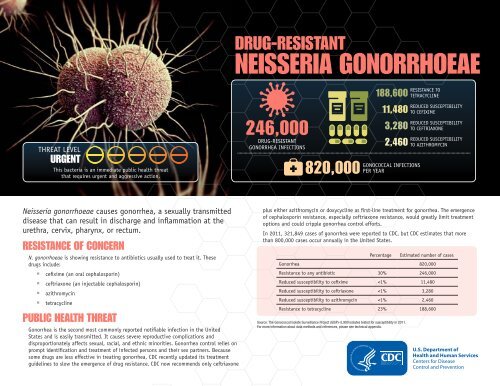Antibiotic Resistance Threats in the United States, 2013 report
Antibiotic Resistance Threats in the United States, 2013 report
Antibiotic Resistance Threats in the United States, 2013 report
Create successful ePaper yourself
Turn your PDF publications into a flip-book with our unique Google optimized e-Paper software.
DRUG-RESISTANT<br />
NEISSERIA GONORRHOEAE<br />
THREAT LEVEL<br />
URGENT<br />
This bacteria is an immediate public health threat<br />
that requires urgent and aggressive action.<br />
246,000<br />
DRUG-RESISTANT<br />
GONORRHEA INFECTIONS<br />
820,000<br />
188,600<br />
11,480<br />
3,280<br />
2,460<br />
GONOCOCCAL INFECTIONS<br />
PER YEAR<br />
RESISTANCE TO<br />
TETRACYCLINE<br />
REDUCED SUSCEPTIBILITY<br />
TO CEFIXIME<br />
REDUCED SUSCEPTIBILITY<br />
TO CEFTRIAXONE<br />
REDUCED SUSCEPTIBILITY<br />
TO AZITHROMYCIN<br />
Neisseria gonorrhoeae causes gonorrhea, a sexually transmitted<br />
disease that can result <strong>in</strong> discharge and <strong>in</strong>flammation at <strong>the</strong><br />
urethra, cervix, pharynx, or rectum.<br />
RESISTANCE OF CONCERN<br />
N. gonorrhoeae is show<strong>in</strong>g resistance to antibiotics usually used to treat it. These<br />
drugs <strong>in</strong>clude:<br />
■■<br />
■■<br />
■■<br />
■■<br />
cefixime (an oral cephalospor<strong>in</strong>)<br />
ceftriaxone (an <strong>in</strong>jectable cephalospor<strong>in</strong>)<br />
azithromyc<strong>in</strong><br />
tetracycl<strong>in</strong>e<br />
PUBLIC HEALTH THREAT<br />
Gonorrhea is <strong>the</strong> second most commonly <strong>report</strong>ed notifiable <strong>in</strong>fection <strong>in</strong> <strong>the</strong> <strong>United</strong><br />
<strong>States</strong> and is easily transmitted. It causes severe reproductive complications and<br />
disproportionately affects sexual, racial, and ethnic m<strong>in</strong>orities. Gonorrhea control relies on<br />
prompt identification and treatment of <strong>in</strong>fected persons and <strong>the</strong>ir sex partners. Because<br />
some drugs are less effective <strong>in</strong> treat<strong>in</strong>g gonorrhea, CDC recently updated its treatment<br />
guidel<strong>in</strong>es to slow <strong>the</strong> emergence of drug resistance. CDC now recommends only ceftriaxone<br />
plus ei<strong>the</strong>r azithromyc<strong>in</strong> or doxycycl<strong>in</strong>e as first-l<strong>in</strong>e treatment for gonorrhea. The emergence<br />
of cephalospor<strong>in</strong> resistance, especially ceftriaxone resistance, would greatly limit treatment<br />
options and could cripple gonorrhea control efforts.<br />
In 2011, 321,849 cases of gonorrhea were <strong>report</strong>ed to CDC, but CDC estimates that more<br />
than 800,000 cases occur annually <strong>in</strong> <strong>the</strong> <strong>United</strong> <strong>States</strong>.<br />
Percentage Estimated number of cases<br />
Gonorrhea 820,000<br />
<strong>Resistance</strong> to any antibiotic 30% 246,000<br />
Reduced susceptibility to cefixime
















